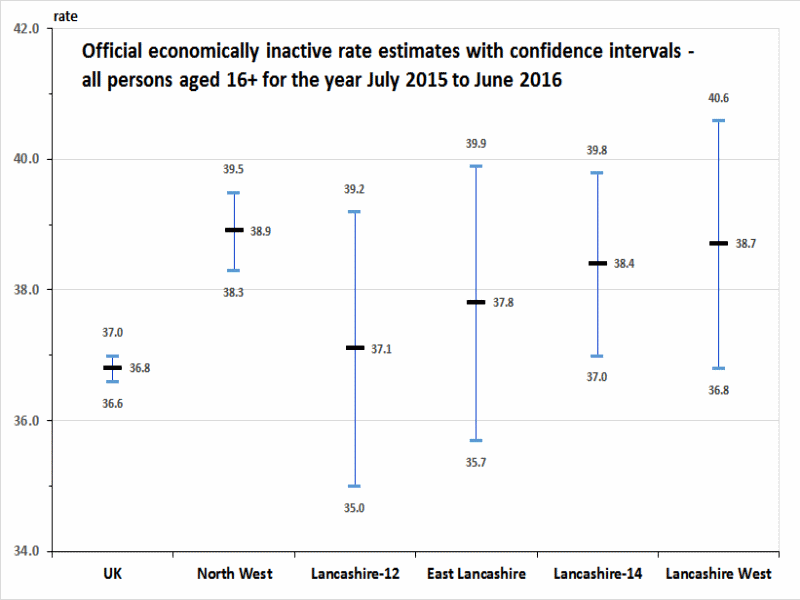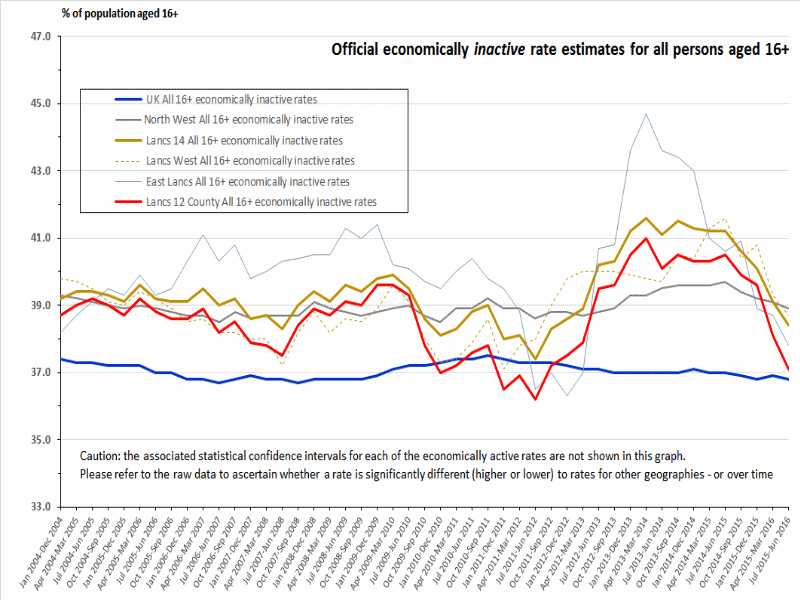16+ economic inactivity
Summary
For the year from July 2015 to June 2016, the UK estimated 16+ economic inactivity rate of 36.8%,(+/- 0.2%) for the year ending June 2016 was statistically lower than the North West rate of 38.9% (+/- 0.6%).
Owing to the wide and overlapping confidence intervals, the estimated 16+ economic inactivity rates for the Lancashire-12 area, at 37.1% (+/- 2.1%), East Lancashire at 37.8% (+/- 2.1%), for the Lancashire-14 area at 38.4% (+/- 1.4%) and for the Lancashire West area at 38.7% (+/- 1.9%) are not statistically higher the UK rate.
The number economically inactive persons aged 16+ in the Lancashire-14 area totalled 452,800 for the year ending June 2016 and 352,500 in the Lancashire-12 area. The totals were 294,500 persons in the Lancashire West area and 158,300 people within East Lancashire.
Figure EI1: 16+ economically inactive rate estimates with confidence intervals for the year July 2015 to June 2016.

Source: Office for National Statistics, Annual Population Survey via the National On-line Manpower Information Sysytem (N.O.M.I.S.).
Change in 16+ economic inactivity since recent peaks
The economic inactivity rate for persons aged 16+ at the UK level has declined by -0.7 percentage points, from the peak of 37.5% (+/- 0.2%) estimated for the year ending September 2011, following the recession, to 36.8% (+/- 0.2%) for the year ending June 2016. This rate is only slightly above the low for the series, of 36.7% (+/- 0.2%) estimated for the year ending September 2008, just as the recession was taking hold, and for the year ending June 2007, prior to the recession.
The 16+ economic inactivity rates (and numbers) for the Lancashire areas have also fallen substantially since their recent peaks, which occurred more recently in 2014 and 2015, but remain above their respective low points for the series (ignoring the +/- confidence intervals).
The 16+ economic inactivity rates have fallen by -6.9 percentage points within East Lancashire, by -3.9 percentage points in the Lancashire-12 area, by -3.2 percentage points in the Lancashire-14 area and by -2.9 percentage points in the Lancashire West area since their recent peaks.
Figure EI2: 16+ economically inactive rate estimates from the year ending December 2004 to the year ending June 2016

Source: Office for National Statistics, Annual Population Survey via the National On-line Manpower Information System (N.O.M.I.S.).
The number of economically inactive persons aged 16+ in the UK has increased by +311,800 persons (+1.6%), from 18,940,300 people for the year ending September 2011, when the peak rate was estimated, to 19,252,100 persons for the year ending June 2016.
By contrast, the number of economically inactive persons aged 16+ have reduced considerably from previous peaks estimated for the year ending March 2014 in the Lancashire-12 area, by -8.8% (-34,100 people), and within East Lancashire, by -16.1% (-30,400 people). For the Lancashire-14 area, numbers have fallen by -7.1% (-34,600 people) since the previous peak, estimated for the year ending September 2014, whilst in the Lancashire West area, numbers have decreased by -6.8% (-21,500 people) since the year ending June 2015.
Note: Economic inactivity versus unemployment
Economic inactivity should not be confused with unemployment. People who are classified as being unemployed are involved in the labour market and are actively seeking employment (as defined) and are deemed to be economically active. People who are categorised as being economically inactive in the UK are defined as persons aged 16 and over without a job, who have not sought work in the last four weeks and/or are not available to start work in the next two weeks. The main economically inactive groups are students, people looking after family and home, long term sick and disabled, temporarily sick and disabled, retired people and discouraged workers.
The economically active population is comprised of those persons aged 16+ who are employed, plus those people who are unemployed aged 16+ (and are actively seeking work). Rates can be calculated for different age groups.
Labour market graphs
A series of labour market graphs has been produced for each of the Lancashire sub-regions that relate to this report. The labour market graphs depict changes to 16+ population levels, economic activity, employment, economic inactivity and unemployment since the year ending December 2004, as well as the associated 16+ rates for these labour market indicators. The graphs are available to download in PDF format via the link in the further analysis box below.
Further analysis
Annual Population Survey 16+ economic inactivity estimates, July 2015 to June 2016, full report (PDF 629 KB)
Annual Population Survey 16+ labour market graphs for Lancashire areas, December 2004 to June 2016 (PDF 2.18 MB)
Page updated December 2016